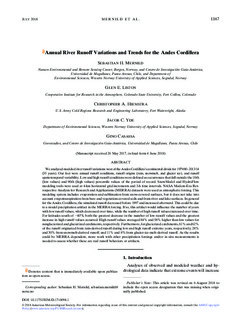| dc.contributor.author | Mernild, Jacob Sebastian Haugaard | |
| dc.contributor.author | Liston, Glen E. | |
| dc.contributor.author | Hiemstra, Christopher A. | |
| dc.contributor.author | Yde, Jacob Clement | |
| dc.contributor.author | Casassa, Gino | |
| dc.coverage.spatial | Andes Cordillera | nb_NO |
| dc.date.accessioned | 2019-03-14T07:44:46Z | |
| dc.date.available | 2019-03-14T07:44:46Z | |
| dc.date.created | 2018-08-01T08:24:25Z | |
| dc.date.issued | 2018 | |
| dc.identifier.citation | Mernild, S. H., Liston, G. E., Hiemstra, C. A., Yde, J. C., & Casassa, G. (2018). Annual river runoff variations and trends for the Andes Cordillera. Journal of Hydrometeorology, 19(7), 1167-1189. | nb_NO |
| dc.identifier.issn | 1525-755X | |
| dc.identifier.uri | http://hdl.handle.net/11250/2589925 | |
| dc.description.abstract | We analyzed modeled river runoff variations west of the Andes Cordillera’s continental divide for 1979/80–2013/14 (35 years). Our foci were annual runoff conditions, runoff origins (rain, snowmelt, and glacier ice), and runoff spatiotemporal variability. Low and high runoff conditions were defined as occurrences that fall outside the 10th (low values) and 90th (high values) percentile values of the period of record. SnowModel and HydroFlow modeling tools were used at 4-km horizontal grid increments and 3-h time intervals. NASA Modern-Era Retrospective Analysis for Research and Applications (MERRA) datasets were used as atmospheric forcing. This modeling system includes evaporation and sublimation from snow-covered surfaces, but it does not take into account evapotranspiration from bare and vegetation-covered soils and from river and lake surfaces. In general for the Andes Cordillera, the simulated runoff decreased before 1997 and increased afterward. This could be due to a model precipitation artifact in the MERRA forcing. If so, this artifact would influence the number of years with low runoff values, which decreased over time, while the number of high runoff values increased over time. For latitudes south of ~40°S, both the greatest decrease in the number of low runoff values and the greatest increase in high runoff values occurred. High runoff values averaged 84% and 58% higher than low values for nonglacierized and glacierized catchments, respectively. Furthermore, for glacierized catchments, 61% and 62% of the runoff originated from rain-derived runoff during low and high runoff extreme years, respectively; 28% and 30% from snowmelt-derived runoff; and 11% and 8% from glacier-ice-melt-derived runoff. As the results could be MERRA dependent, more work with other precipitation forcings and/or in situ measurements is needed to assess whether these are real runoff behaviors or artifacts. | nb_NO |
| dc.language.iso | eng | nb_NO |
| dc.publisher | American Meteorological Society | nb_NO |
| dc.rights | Navngivelse 4.0 Internasjonal | * |
| dc.rights.uri | http://creativecommons.org/licenses/by/4.0/deed.no | * |
| dc.subject | regional effects | nb_NO |
| dc.subject | land surface model | nb_NO |
| dc.subject | hydrologic models | nb_NO |
| dc.subject | rivers | nb_NO |
| dc.subject | land surface | nb_NO |
| dc.subject | glaciers | nb_NO |
| dc.title | Annual River Runoff Variations and Trends for the Andes Cordillera | nb_NO |
| dc.type | Journal article | nb_NO |
| dc.type | Peer reviewed | nb_NO |
| dc.description.version | publishedVersion | nb_NO |
| dc.rights.holder | © 2018 American Meteorological Society | nb_NO |
| dc.subject.nsi | VDP::Matematikk og Naturvitenskap: 400::Geofag: 450::Meteorologi: 453 | nb_NO |
| dc.source.pagenumber | 1167-1189 | nb_NO |
| dc.source.volume | 19 | nb_NO |
| dc.source.journal | Journal of Hydrometeorology | nb_NO |
| dc.source.issue | 7 | nb_NO |
| dc.identifier.doi | 10.1175/JHM-D-17-0094.1 | |
| dc.identifier.cristin | 1599253 | |
| cristin.unitcode | 203,12,7,0 | |
| cristin.unitname | Institutt for miljø- og naturvitskap | |
| cristin.ispublished | true | |
| cristin.fulltext | original | |
| cristin.qualitycode | 1 | |

